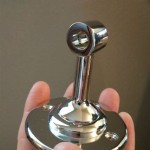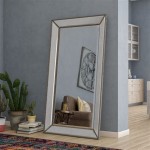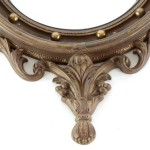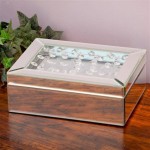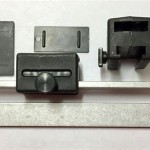What Is a Convex Mirror for Cars?
Convex mirrors, often referred to as "fish-eye" mirrors or "diverging" mirrors, are a crucial safety feature in modern vehicles. They provide a wider field of view than flat or plane mirrors, allowing drivers to see more of the surrounding environment, particularly in blind spots.
The defining characteristic of a convex mirror is its outward curvature. This curved surface reflects light rays outwards, effectively expanding the reflected image and providing a broader perspective. While the image appears smaller than in a flat mirror, the increased field of view significantly enhances driver awareness.
The physics behind the operation of a convex mirror lies in the principles of reflection and refraction of light. When light rays strike the curved surface of the mirror, they are reflected outward at angles determined by the angle of incidence and the curvature of the mirror. This divergent reflection creates a virtual, upright, and diminished image of the objects behind the car.
The "virtual" nature of the image means that the light rays don't actually converge to form an image, but appear to originate from a point behind the mirror. The image is "upright" as it maintains the same orientation as the object being reflected. Finally, the "diminished" nature indicates that the image appears smaller than the actual size of the object.
The primary application of convex mirrors in cars is to enhance driver visibility. Located typically on the passenger-side wing mirror and sometimes on the driver's side, these mirrors provide a wide-angle view of the adjacent lanes, assisting in lane changes and reducing blind spots. This added visibility is particularly helpful in navigating tight spaces, merging into traffic, and parking.
The expanded field of view offered by convex mirrors comes with a trade-off. The diminished size of the reflected objects can make it difficult to judge the distance and speed of approaching vehicles accurately. This is why convex mirrors often carry the warning "Objects in mirror are closer than they appear." This warning reminds drivers to account for the distorted perspective and exercise caution when relying on the mirror's reflection.
Different types of convex mirrors are utilized in vehicles, distinguished primarily by their shape, size, and features. Circular convex mirrors are common, offering a balanced field of view. Aspherical convex mirrors, with varying curvatures across their surface, can further enhance visibility by minimizing distortion in specific areas. Some convex mirrors incorporate features like blind-spot monitoring sensors or heating elements to improve functionality in various conditions.
The installation and adjustment of convex mirrors are crucial for their effectiveness. They must be positioned to maximize the field of view without creating excessive distortion or obstructing the driver's view of the surrounding environment. Proper adjustment ensures that the driver can effectively utilize the mirror to enhance awareness and make informed driving decisions.
Maintaining convex mirrors is essential for preserving their functionality. Regular cleaning is necessary to remove dirt, grime, and other obstructions that can impair visibility. Damaged or deteriorated mirrors should be replaced promptly to maintain optimal safety. Periodic inspection of the mirror's mounting and adjustment ensures that it remains securely in place and provides the intended field of view.
The use of convex mirrors in vehicles exemplifies the integration of physics principles to enhance safety and driving experience. By understanding the properties of light reflection and the unique characteristics of convex surfaces, engineers have developed a simple yet effective tool that significantly expands driver awareness and contributes to safer road conditions.
Regulations regarding the use of convex mirrors vary by jurisdiction. Some regions mandate the use of convex mirrors on specific vehicle types, while others provide guidelines for their size, placement, and features. Understanding and adhering to these regulations are essential for ensuring vehicle compliance and safety.
The evolution of convex mirror technology continues, driven by advancements in materials science and optical engineering. Researchers are exploring new materials and designs that can improve image clarity, reduce distortion, and integrate with other vehicle safety systems. These developments promise to further enhance the effectiveness of convex mirrors in promoting road safety.
While advanced driver-assistance systems (ADAS) like blind-spot monitoring and lane departure warnings are becoming increasingly prevalent, convex mirrors remain a fundamental and cost-effective safety feature in vehicles. Their wide field of view provides crucial visual information that complements these advanced systems, contributing to a more comprehensive understanding of the vehicle's surroundings.
Convex mirrors play a critical role in driver safety by expanding the field of vision and reducing blind spots. Their proper use, combined with driver attentiveness and adherence to safety practices, significantly contributes to safer driving experiences and reduced accident risks.

Convex Mirrors Use Car

Convex And Concave Mirrors In Cars

Concave Vs Convex Mirrors In Cars
Why Is A Convex Mirror Preferred For Use As Driving Over Plane Quora

Types Of Mirror For Vehicles Concave Vs Convex Sunway Autoparts

Small Car Mirror 360 Wide Angle Round Convex Vehicle Side Blind Spot

Replace Convex Mirror To Flat

2pcs Blind Spot Mirror Rearview Convex Side Mirrors For Cars Suv Truck Van Stick On 3m Adhesive Rear View Hd Glass Frameless Sway Rotate Adjustable Wide Angle 2 Inch Round Com

Why Do We Prefer A Convex Mirror As Rear View In Vehicles
In Trucks Cars Buses Side View Mirrors Are Convex But Center Rear Mirror Is Or Plane Quora

